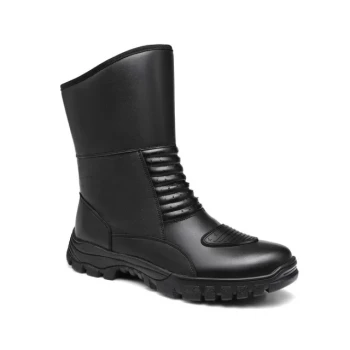To be clear, flexible-soled boots are recommended for general winter activities like walking or hiking because they promote warmth, but they are not suitable for performance skiing. For downhill or cross-country skiing, a rigid boot is essential for control, power transfer, and safety, as it must lock into a binding.
The core principle to understand is the fundamental trade-off between warmth and performance. A flexible sole enhances warmth by allowing your foot to move naturally, while a rigid sole provides the non-negotiable control required to maneuver skis.

The Principle of Warmth: Why Flexibility Matters
When you see advice recommending flexible boots for winter, it is based on sound physiological principles related to staying warm, not on performance skiing.
How Movement Generates Warmth
A flexible boot allows your foot to bend naturally at the ball of the foot with each step. This movement is critical.
The muscles in your feet and toes contract and relax as you walk, a process that generates a small but constant amount of heat.
The Role of Blood Circulation
This natural walking motion acts like a pump, promoting better blood circulation to your extremities.
Good circulation is the body's primary mechanism for delivering warmth to the feet and toes, which are often the first areas to get cold. Rigid boots can constrict this natural movement, leading to reduced circulation and colder feet.
Sizing and Airflow
Proper sizing, which is easier to achieve in a flexible winter boot, also plays a role.
Sizing up to accommodate thicker socks leaves a small pocket of air around your foot. This trapped air is heated by your body and acts as a crucial layer of insulation. A flexible boot allows for more toe-wiggling room, which helps maintain this warm air pocket.
Understanding the Trade-offs: Warmth vs. Control
The choice between a flexible and a rigid boot is not about which is "better" overall, but which is correct for a specific task. Confusing their applications can be ineffective and dangerous.
The Cost of Flexibility: Loss of Power
For actual skiing, your boot is the direct connection to your ski. A flexible sole would absorb and dissipate the energy you exert.
All the subtle movements you use to steer, edge, and control your skis would be lost, making it impossible to ski effectively or safely. This is why ski boots are made from hard plastics.
The Cost of Rigidity: The Challenge of Warmth
The primary drawback of a rigid ski boot is its potential to restrict circulation.
Because the boot must be snug to ensure control, it can limit the natural flexing of the foot. This is why finding a properly fitted ski boot and using high-quality ski socks is so critical for skiers who get cold feet.
Modern Ski Boot Solutions
Modern ski boot technology attempts to mitigate this trade-off.
Many backcountry and alpine touring boots feature a "walk mode." This mechanism allows the ankle cuff to pivot, providing a greater range of motion for walking or hiking up a slope. However, the sole of the boot remains rigid to interface with the binding.
Making the Right Choice for Your Activity
Selecting the correct footwear depends entirely on what you plan to do.
- If your primary focus is walking in a ski village, winter hiking, or snowshoeing: Choose a well-insulated, waterproof boot with a flexible sole to maximize warmth and comfort.
- If your primary focus is downhill or resort skiing: A rigid, properly fitted ski boot is the only safe and effective option. Focus on fit and sock systems to manage warmth.
- If your primary focus is backcountry touring: Select a specialized touring boot that has a rigid sole but incorporates a "walk mode" for efficient uphill travel.
Ultimately, choosing the right boot means matching its design to your specific activity to ensure both safety and comfort.
Summary Table:
| Activity | Recommended Boot Type | Key Benefit |
|---|---|---|
| Walking / Hiking | Flexible Sole | Maximizes warmth via natural movement and circulation |
| Downhill / Resort Skiing | Rigid Sole | Provides essential control, power transfer, and safety |
| Backcountry Touring | Rigid Sole with Walk Mode | Balances uphill hiking efficiency with downhill performance |
Need the right boots for your target market? As a large-scale manufacturer, 3515 produces a comprehensive range of footwear for distributors, brand owners, and bulk clients. Our production capabilities encompass all types of shoes and boots, from insulated flexible winter boots for casual wear to high-performance rigid ski boots. Let us help you source the perfect footwear to meet your customers' needs for safety, comfort, and performance. Contact our experts today to discuss your requirements!
Visual Guide

Related Products
- Factory-Direct Wholesale Canvas Boots with High-Traction Rubber Soles
- High Performance Fire-Retardant Waterproof Safety Boots
- Premium Wholesale Waterproof Safety Boots High Performance Protection for Industrial Markets
- Premium High-Cut Waterproof Safety Boots Manufacturing & Wholesale Solutions
- Customizable Anti-Smash Safety Boots for Wholesale & Private Label Manufacturing
People Also Ask
- What role do slip-resistant rubber materials play in safety shoes? Ensuring Grip and Stability in Hazardous Workplaces
- What are the advantages of rubber soles in safety boots? Unbeatable Grip & Durability
- What should be avoided when storing boots with outsoles? Protect Your Investment from Dry Rot & Decay
- What is a vulcanized sole? Discover the Secret to Superior Flexibility and Grip
- What types of rubber are typically employed in non-slip footwear soles? Your Guide to Maximum Grip and Safety



















